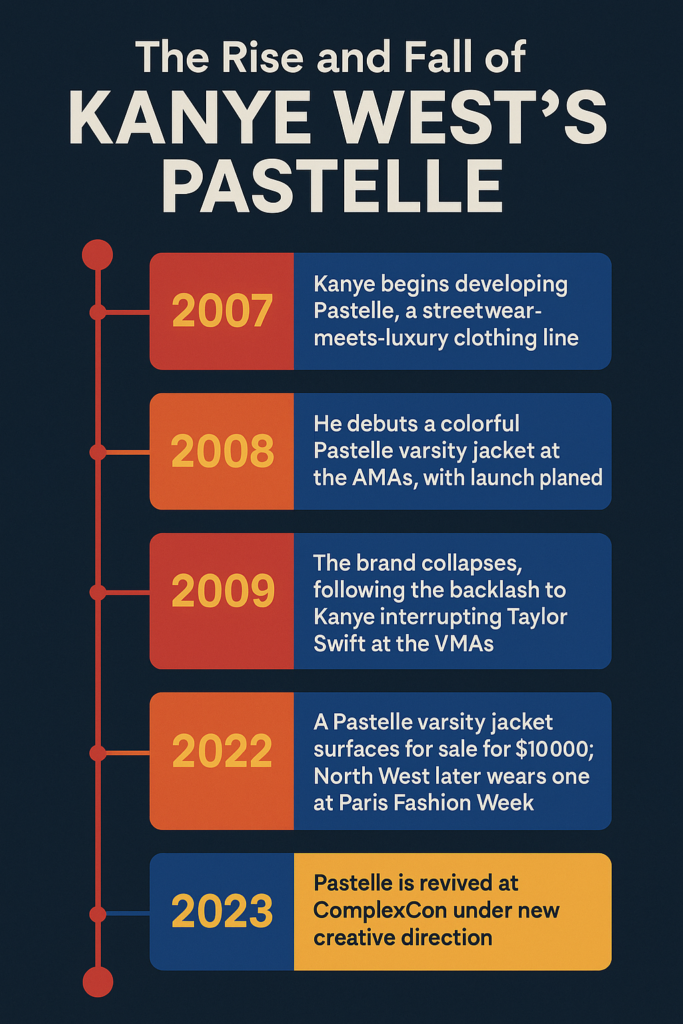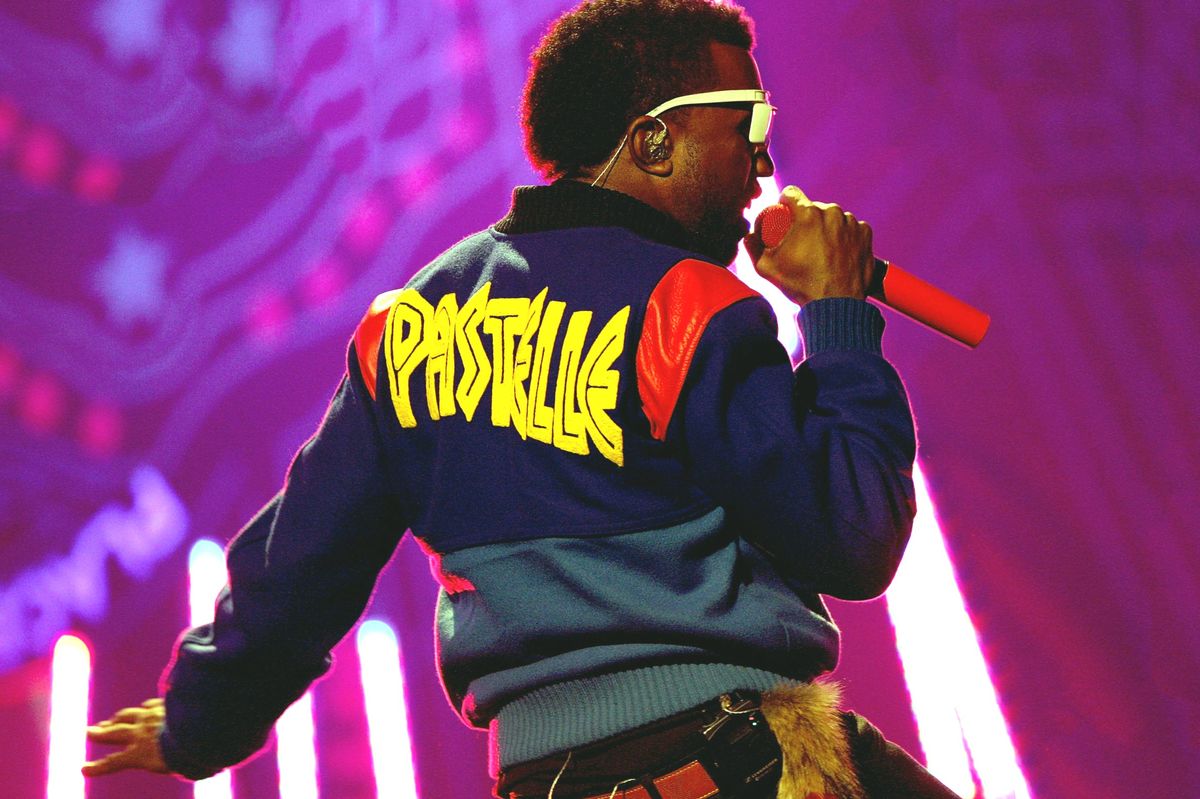Back in the late 2000s, Kanye West stood at the crossroads of music and fashion. He had already transformed hip-hop sound and style, but he wanted more. Kanye wanted to build his own fashion empire, something that could stand next to Ralph Lauren or Louis Vuitton. Pastelle was the first serious step in that direction.
Pastelle was not just a logo on hoodies. Kanye wanted it to be a real fashion house, with varsity jackets, hoodies, accessories, and even eyewear. The idea mixed streetwear with luxury, years before “street-luxury” became a mainstream thing. When Kanye wore the bright blue, red, and yellow varsity jacket at the 2008 American Music Awards, fans and fashion insiders saw it as the symbol of Pastelle. Magazines talked about it, blogs speculated about the release, and hype built up quickly. People expected a full launch by January 2009.
Kanye described Pastelle as a kind of university for himself, a place where he could learn design and build credibility as a fashion creator. Unlike many celebrity brands that start with licensed merch, Kanye tried to build Pastelle with serious designers and industry names. This gave the project more weight but also made it more complicated.
The team behind the brand
Kanye never worked alone. He surrounded himself with people who later became major forces in fashion. Virgil Abloh, who would go on to become artistic director of Louis Vuitton menswear and founder of Off-White, worked closely with him in this period. Other consultants included Kim Jones, who later rose to fame as a creative director at Dior and Fendi. Stylists, graphic designers, and streetwear figures joined in.
This roster gave Pastelle a kind of underground credibility. The brand looked less like a celebrity side hustle and more like a serious design lab. But this also raised expectations. When you involve names like Abloh and Jones, the fashion world expects polished, high-end results, not just a few hoodies and tees. Meeting those expectations requires serious money, tight production schedules, and industry infrastructure. Kanye had vision and talent around him, but he lacked the machinery that most successful fashion houses rely on.
The build-up of hype
Between 2007 and 2009, Kanye teased Pastelle constantly. He wore samples in public, leaked images appeared online, and style blogs treated the brand like the next big thing. The colorful varsity jacket became a holy grail piece, and other samples like bold graphic hoodies circulated in editorials. By early 2009, magazines reported that Pastelle would officially launch with a full line.
The problem was that the brand had already gone public before the behind-the-scenes work finished. Pastelle existed more in rumor and imagery than in warehouses and stores. Kanye created anticipation, but he had not secured stable production or retail partners. Fashion brands cannot survive on hype alone. You need factories to make the clothes, distribution networks to get them into stores, and marketing teams to manage timing. Pastelle had design credibility but not enough business muscle.
Personal tragedy and shifting focus
Behind the creative work, Kanye’s personal life also shaped Pastelle’s fate. In 2007, his mother, Donda West, passed away unexpectedly. This loss hit him deeply and changed the way he moved in both music and fashion. He spoke often about how much she influenced him and guided his choices. Losing her left him in a period of grief and searching.
During this time, Kanye’s attention was divided. He still pushed forward with Pastelle, but the emotional weight slowed his focus. Launching a fashion line requires nonstop energy and meticulous planning. Any pause, especially in such a competitive industry, can stall momentum. Kanye carried the burden of personal tragedy at the exact moment when Pastelle needed his sharpest focus.
The 2009 VMA controversy
If there was one single event that truly killed Pastelle’s chance of launching, it was the 2009 MTV Video Music Awards. Kanye stormed the stage while Taylor Swift gave her acceptance speech, grabbed the microphone, and said Beyoncé deserved the award instead. The world exploded with coverage. The media painted Kanye as arrogant and reckless, and the backlash was immediate and massive.
At that exact moment, Pastelle was supposed to be preparing for launch. No fashion brand wants to debut under a storm of bad publicity. Big retail partners prefer stability and good press. Kanye’s outburst created the worst possible climate to launch an ambitious fashion label. Instead of headlines about his designs, every article focused on the controversy.
The timing could not have been worse. A celebrity can weather scandals if their brand already has roots, but a brand still in its fragile early stage cannot survive such negative attention. Pastelle never recovered from the VMA moment.
The money problem
Fashion is expensive. Making samples is one thing; producing thousands of pieces for stores is another. Factories demand money up front. Shipping, marketing, and distribution cost millions. Kanye underestimated how much capital he needed. Unlike music, where distribution is cheap once a song is recorded, fashion requires huge upfront investments before a single hoodie reaches a customer.
Later in his career, Kanye admitted he lost large sums of money in fashion. At one point, he spoke about being millions in debt from trying to fund his creative projects. Pastelle was part of those early struggles. He had the ambition of a luxury brand but not the financial machinery. Without stable investors or retail partners, the line could not move from samples to shelves.
The creative mismatch
Kanye’s vision for Pastelle was bold. The designs used bright colors, unique cuts, and experimental styles. This appealed to fashion insiders but confused mainstream buyers in 2009. Streetwear had not yet fully crossed into luxury. Supreme was still mostly underground, and brands like Off-White had not yet arrived. Kanye was ahead of his time, but sometimes being early feels the same as being wrong.
Retailers looked at Pastelle and did not see an easy sell. Who would pay luxury prices for streetwear silhouettes in 2009? The market was not ready. When Yeezy finally launched years later, the world had shifted. People were ready to spend big on sneakers and hoodies because the culture had matured. Pastelle simply hit the wrong moment.
The jacket that became a legend
Even though Pastelle never launched, it left behind a few legendary artifacts. The varsity jacket Kanye wore at the 2008 AMAs resurfaced years later. A consignment store listed one for $10,000 in 2022. Collectors treated it as a holy grail, not because of its design alone but because of its story.
In 2022, Kanye’s daughter North West wore one of the original Pastelle jackets during Paris Fashion Week. The moment went viral, reminding everyone of the myth of Pastelle. The jacket symbolized both the promise and the failure of the brand. It proved that scarcity and story could make a piece more valuable than any runway collection.
The lessons Kanye carried forward
Pastelle may have failed, but Kanye used the experience to reshape his later fashion career. After Pastelle, he partnered with Nike to release the Air Yeezy sneakers. Later, he struck a huge deal with Adidas to build the Yeezy brand. Unlike Pastelle, these projects had industrial-scale partners who could handle factories, distribution, and retail.
Kanye provided vision, hype, and design. Nike and Adidas provided infrastructure and money. The result was a global phenomenon. Yeezy sneakers sold out instantly, generated billions in revenue, and shaped sneaker culture worldwide. Kanye learned from Pastelle that ambition alone does not make a fashion brand. You need the boring parts — the factories, contracts, supply chains — as much as the creativity.
Pastelle also taught him the power of myth. The scarcity of the early pieces and the unfinished story of the brand made Pastelle part of fashion folklore. Kanye leaned into this lesson with Yeezy, releasing sneakers in limited runs that created frenzy and resale markets.
Attempts to bring Pastelle back
Pastelle never completely disappeared. In November 2023, the brand appeared again at ComplexCon in Long Beach. Influencer Ian Connor, designer Christian Azzinaro, and stylist Bloody Osiris presented Pastelle pieces to the public. This revival was more about nostalgia than a true commercial relaunch.
The new Pastelle faced challenges of its own. The fashion world in 2023 was very different from 2009. Streetwear had become crowded, with hundreds of brands competing for attention. Consumers who remembered the original hype were older, and younger fans had their own brands to follow. Reviving Pastelle meant balancing history with modern appeal.
There were also questions about authenticity. Kanye himself was not directly steering the revival. Without his leadership, some fans questioned whether it truly carried the spirit of the original project. Still, the fact that Pastelle returned to public shows how strong its myth remains.
Why celebrity brands fail so often
Pastelle fits into a bigger story about celebrity fashion. Many stars try to launch labels, but most fail. The main reasons are the same ones Kanye faced. They underestimate how complex the fashion industry is. They hype projects before the business foundation is ready. They face bad timing with scandals or shifts in culture. And they often lack the capital to turn samples into real products.
A few celebrity brands succeed because they choose the right partners. Rihanna’s Fenty line succeeded under LVMH because it had luxury infrastructure. Kanye’s later Yeezy line thrived under Adidas because it had global manufacturing. Celebrities who try to do everything alone usually stumble.

The legacy of Pastelle
Pastelle never opened stores or launched full collections. Yet it left behind a story bigger than many brands that lasted decades. It showed Kanye’s early ambition, his willingness to take risks, and his struggle to balance creativity with business. It introduced the world to collaborators like Virgil Abloh, who later reshaped fashion on a global scale.
The colorful varsity jacket became one of the most talked-about single pieces of clothing in modern fashion history. Its resale value and its reappearance on Kanye’s daughter decades later prove that fashion can succeed in culture even if it fails in business.
Most importantly, Pastelle shaped the way Kanye approached fashion in the future. Without this failure, there may have been no Yeezy empire. Pastelle was the first draft, the experiment, the lesson in what happens when hype runs ahead of execution.
Conclusion
Kanye West wanted Pastelle to stand next to the world’s great fashion houses. He built hype, assembled a dream team, and put bold designs into the spotlight. But personal tragedy, the fallout of the 2009 VMA scandal, a lack of financial and operational infrastructure, and a market that was not ready combined to stop the brand before it could take off.
Still, Pastelle became more than just a failed brand. It turned into a legend. The few surviving pieces became collectibles. The story of its rise and fall taught Kanye how to build a real fashion business later. And for fans, Pastelle remains one of the great “what ifs” of streetwear history.
Also Read – Creative Ways to Raise Capital Without VC Money
